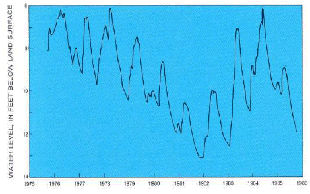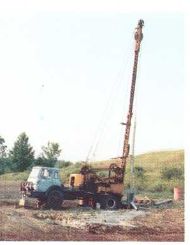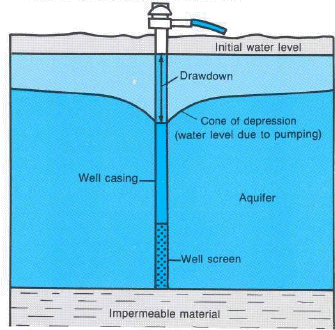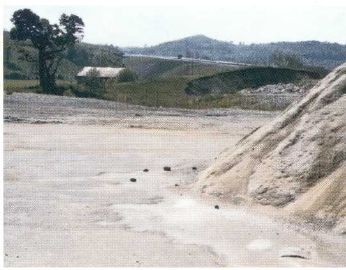Effects of long-term climatic trends on ground-water storage
In addition to seasonal fluctuations in ground-water storage, long-term
trends result from the variations in precipitation. Several years of
below-normal precipitation causes a progressive decline in ground-water levels,
and several years of above-normal precipitation causes a corresponding rise.
These long-term climatic trends cause changes in ground-water storage. During
periods of long-term, above-average precipitation, the water table may rise
close to the land surface and interfere with home construction and waste
disposal. For example, if a home had been built with a basement 8 feet below
land surface during 1980-82 at the site of the well whose hydrograph is shown
below, the basement would have been flooded in 1983 and 1984.

A 10-year well hydrograph showing climatic effects on ground-water level.
Types of Wells
Most modern wells are drilled by truck-mounted percussion (cable-tool) or
rotary (air or hydraulic) drill rigs. Dug wells are still constructed in some
areas, either by power equipment or by hand, but most hand-dug wells are
the"relics" of older homes and were dug before drilling equipment was readily
available or because drilling was considered too expensive. Driven wells,
installed by hand or with power equipment, are still common and widely used
where geologic conditions permit. Jetted and bored (augered) wells are less
common types.

Types of wells.
Dug wells
Historically, dug wells were excavated by hand shovel to below the water
table until incoming water exceeded the digger's bailing rate. The well was
lined with stones, brick, tile, or other material to prevent collapse, and was
covered with a cap of wood, stone, or concrete. Modern large-diameter dug wells
are dug or bored by power equipment and typically are lined with concrete tile.
Because of the type of construction, bored wells can go deeper beneath the water
table than can hand-dug wells.
Dug and bored wells have a large diameter and expose a large area to the
aquifer. These wells are able to obtain water from less-permeable materials such
as very fine sand, silt, or clay. Some disadvantages of this type of well are
that they are shallow and lack continuous casing, making them subject to
contamination from nearby surface sources, and they go dry during periods of
drought if the water table drops below the well bottom.

Modern truck-mounted drill rig
Driven wells
Driven wells are constructed by driving small-diameter pipe into shallow
water-bearing sand or gravel. Usually a screened well point is attached to the
bottom of the casing before driving. These wells are relatively simple and
economical to construct, but they can tap only shallow water and, like dug
wells, are easily contaminated from nearby surface sources.
Drilled wells
Drilled wells are constructed by either percussion or rotary-drilling
machines. Drilled wells that penetrate unconsolidated material require
installation of casing and a screen to prevent inflow of sediment and collapse.
They can be drilled more than 1,000 feet deep. To prevent contamination by water
draining from the surface downward around the outside of the casing, the space
around the casing must be sealed.
Wells and Pumpage
Even though water is present at some depth at almost any location, the
success of obtaining an adequate domestic supply (usually 5 gallons per minute)
of water from a well depends upon the permeability of the rock. Where permeable
materials are near land surface, a shallow well may be adequate. Elsewhere, such
as where clayey material directly overlies bedrock, a deep well extending into
bedrock may be needed.
Pumping a well lowers the water level around the well to form a cone of
depression in the water table. If the cone of depression extends to other nearby
wells, the water level in those wells will be lowered. The cone develops in both
shallow water-table and deeper confined-aquifer systems. In the deeper
confined-aquifer system, the cone of depression is indicated by a decline in the
pressure and the cone spreads over a much larger area than in a water-table
system. For a given rate of withdrawal, the cone of depression extends deeper in
low-yielding aquifers than in high-yielding ones.

Cone of depression caused by pumping.
Water-Level Declines
The old saying that you "never miss the water until the well runs dry"
remains true; however, few drilled wells ever actually go dry. Rather,
what occurs most often is that the water table has dropped to near or below the
pump intake because the pump intake is not set deep enough to allow for a
potential decline in water levels. Alternatively, the small strainer that covers
the end of the pump intake could be partly clogged so that it takes longer to
pump the same amount of water. In either case, when the pumping rate exceeds
inflow to the well, air is pumped and no more water is produced until the pump
is shut off and the well recovers.
Shallow wells
The most common "dry well" problem has been with dug wells. Most dug wells
are shallow and excavated in poorly permeable material ; consequently they are
readily affected by drought or by seasonal declines in the water table. The
following figure shows the effect of declining water levels on two adjacent
wells that are drilled to different depths on either side of a water-table pond.
If the depth to water in the well on the left were, say, 10 feet during spring,
it might decline to 15 feet during late summer or during a severe drought. If
the pump normally causes the water level in the well to decline 5 feet or more
during a pumping cycle, pumping during the drought would cause the water to
decline to or below the pump intake. Excavating this well deeper to match the
well on the right would solve this problem. Dug wells should be constructed
during seasonal or climatically low-water-level periods.
Many dug wells extend only to the bedrock surface and tap the perched water
(unconfined ground water separated from an underlying main body of ground water
(aquifer) by an unsaturated (impermeable) zone) on top of the bedrock. These
wells cannot be easily deepened. In such cases a new drilled well is the only
long-term solution.

How does a well go dry?

Solving a drought-related water shortage by deepening the well.
Some drilled wells that tap shallow bedrock will yield only 1 or 2 gallons of
water per minute. These wells are not deep enough to provide adequate storage of
water for short-term pumping cycles. Such a well may contain only 50 feet of
water above the pump intake. As an example, when the water table declines 10
feet because of drought conditions, only 40 feet of water is available in the
well for one pumping cycle, and the well seems to "go dry." In that situation,
deepening the well may solve the problem as long as the deeper water is of good
quality. If usable water is not available at a greater depth, the pumping rate
must be reduced so that less water is pumped during each cycle.
Increased pumping in the immediate area
Another reason that wells "go dry" is the lowering of the water table by
increased pumpage in the immediate area. Housing developments with small lots
and individual wells have been built in many rural areas. If the aquifer is low
yielding so that pumping causes a large drawdown, a cone of depression will
develop around each well. Thus, several domestic wells close together can create
a steady lowering of the water table if pumpage exceeds the natural recharge to
the system (unless the withdrawn water is returned to the aquifer through septic
systems). A third major reason that rural wells "go dry" is the installation of
larger capacity wells for municipal, industrial, or agricultural purposes
adjacent to residental areas. The increased withdrawals may cause large
widespread cones of depression that intersect one another and cause general
water-level declines that affect nearby domestic wells.

Effect of concentrated housing on ground-water level.
Water-Level Rises
The opposite problem, namely a rising water table, has developed in some
parts of the country. Rising water tables occur in areas where pumpage has been
curtailed after years of large ground-water withdrawals, such as for mine
dewatering or municipal water supply, which kept the water table below its
natural levels. The curtailment of pumping allows the water table to rise to the
previous natural level, which may flood underground structures that were built
when the water table was lowered.
In many parts of the country, water levels in shallow aquifers have been
lowered artificially over large areas. If houses are constructed in dewatered
areas and if the water table then recovers to its natural (higher) level,
basement flooding or foundation failures may occur, especially where the natural
water level is within 10 feet of the land surface. Many basements that were
built in a dry unconsolidated material and that had remained dry for decades
have now become permanently wet. The public's first reaction may be that
unusually heavy precipitation in the past few months has raised the water table
or created a temporary perched-water system, when in fact the situation is much
more serious and will remain a problem unless pumping is resumed to maintain a
lower water table.
Where water levels are closely monitored, water-level records can indicate
whether such high water levels are related solely to climatic events or whether
water levels are recovering after nearby pumping has ceased. An increasing
number of local areas are being dewatered for mining or industrial uses, which
could cause serious problems in the future when such pumpage is decreased or
ended.
Similar situations have occurred where housing developments were built during
a period of extended drought when the water table was low. Even if basements
were the "daylight" or raised type because the natural water table was shallow,
the eventual return of a wet period caused the water table to rise a few feet
and flood basements.
Quality of Water
Some common ground-water quality concerns are excessive hardness (high
dissolved magnesium and calcium content), a high concentration of salt or iron,
or the presence of hydrogen sulfide (sulfur), methane gas, petroleum or organic
compounds, or bacteria. Some are naturally occurring; others are introduced by
human activities. In many areas, the homeowner has little recourse other than to
use chemical treatment to remove or reduce the level of these constituents or to
abandon the water supply. Hardness, iron, and sulfur are common constituents
that can be treated.
Salt contamination
Salt contamination is difficult and expensive to remedy unless the well
drawing saline water from a deep aquifer also penetrates one or more freshwater
aquifers at lesser depth. In such cases, the deep saline aquifer can be sealed
off and the well can be drilled in the freshwater aquifer instead. In many parts
of the country, however, when a well is drilled deeper into bedrock to obtain
larger supplies, saline water is more likely encountered than additional
freshwater is.
Road-salt contamination of ground water has increased in the last 30 years
and is of major concern in northern areas. Highway departments mix salt with
sand to spread on roads for deicing. Salt is readily soluble in water and runs
off highways into lakes and streams and percolates to the water table.
Probably more serious than the spreading is the stockpiling of uncovered salt
and sand mixtures. This practice produces concentrated saltwater runoff that
percolates to underlying aquifers and nearby wells. Many stockpiles are within
small villages or near housing areas where nearby domestic wells can become
contaminated.

Leachate from sand and salt stockpiles is a potential
source of contamination to shallow ground water.
|

